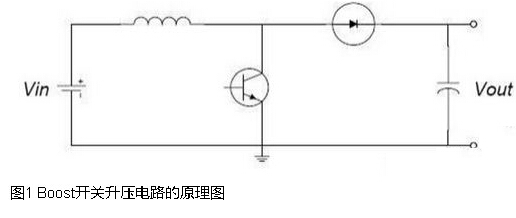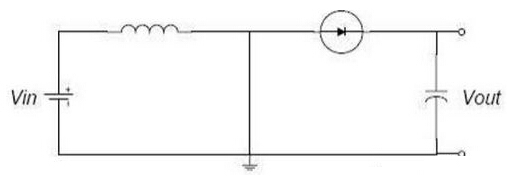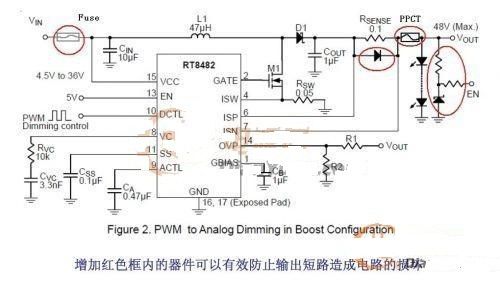Four unique tricks of boost boost circuit that engineers want to learn
Time:2022-05-24
Views:2148
The three most common structural layouts of switching power supply are buck, boost and buck boost. These three layouts are not isolated from each other.
The boost converter (or step-up converter) is a common switching DC boost circuit, which can make the output voltage higher than the input voltage.
The following is mainly described from three aspects: the basic principle, the parameter design of boost circuit and how to add protection circuit to boost circuit.
Basic principle analysis of Part1 boost circuit
Boost circuit is a switching DC boost circuit, which can make the output voltage higher than the input voltage. It is a common circuit design method in electronic circuit design.
First, you need to know the basics:
Capacitance hinders voltage change, high frequency, low frequency, AC and DC;
Inductance hinders the change of current, connects low frequency, resists high frequency, connects DC and resists AC;

Suppose that the switch (triode or MOS) has been off for a long time, all components are in an ideal state, and the capacitance voltage is equal to the input voltage.
The circuit is divided into two parts: charging and discharging.
Charging process

During the charging process, the switch is closed (the triode is on), the equivalent circuit is shown in the figure above, and the switch (triode) is replaced by a wire. At this time, the input voltage flows through the inductor. The diode prevents the capacitor from discharging to ground. Since the input is DC, the current on the inductor increases linearly at a certain ratio, which is related to the size of the inductor. As the inductance current increases, some energy is stored in the inductance.
Discharge process

As shown in the figure above, this is the equivalent circuit when the switch is off (triode is off). When the switch is off (the triode is off), due to the current holding characteristics of the inductor, the current flowing through the inductor will not immediately change to 0, but slowly change from the value at the end of charging to 0. The original circuit has been disconnected, so the inductor can only discharge through the new circuit, that is, the inductor starts to charge the capacitor, and the voltage at both ends of the capacitor rises. At this time, the voltage is already higher than the input voltage. Boost completed.
In short, the boost process is an inductive energy transfer process. When charging, the inductor absorbs energy, and when discharging, the inductor releases energy. If the capacitance is large enough, a continuous current can be maintained at the output during the discharge. If this on-off process is repeated, a voltage higher than the input voltage can be obtained at both ends of the capacitor.
Design of Part 2 boost circuit parameters
For boost circuit, the continuous mode of inductive current is very different from the discontinuous mode of inductive current. The output voltage of discontinuous mode is related to the input voltage, inductance, load resistance, duty cycle and switching frequency. The output voltage of continuous mode only depends on the input voltage and duty cycle.
Selection of output filter capacitor
In switching power supply, the function of output capacitor is to store energy and maintain a constant voltage.
The capacitance selection of boost circuit is mainly to control the output ripple within the specified range.
For boost circuit, the impedance of capacitor and output current determine the output voltage ripple.
The impedance of the capacitor consists of three parts: equivalent series inductance (ESL), equivalent series resistance (ESR) and capacitance value (c).
In the inductive current continuous mode, the capacitance depends on the output current, switching frequency and desired output ripple. When the MOSFET is turned on, the output filter capacitor provides the whole load current.
inductance
In switching power supply, the function of inductance is to store energy.
The function of inductance is to maintain a constant current, or to limit the change of current in inductance.
In a boost circuit, choosing an appropriate inductance is usually used to limit the ripple current flowing through it.
The ripple current of the inductor is directly proportional to the input voltage and MOSFET on-time, and inversely proportional to the inductance. The inductance determines the operating points of continuous mode and discontinuous mode.
In addition to the inductance, the selection of inductance should also pay attention to its maximum DC or peak current and maximum working frequency.
If the inductance current exceeds its rated current or the working frequency exceeds its maximum working frequency, the inductance will be saturated and overheated.
MOSFET
In the low-power DC / DC variation, power MOSFET is the most commonly used power switch. The cost of MOSFET is relatively low and the working frequency is relatively high.
The selection of MOSFET in the design mainly considers its conduction loss and switching loss.
MOSFET is required to have sufficiently low on resistance RDS (on) and relatively low gate charge QG.
Part3 put protective clothing on boost circuit
In the previous part, we understand the boost circuit and the design of boost circuit parameters from the perspective of charge and discharge.
As a non isolated boost circuit, boost circuit has the advantages of simple structure, easy design and low cost. It is widely used in various boost occasions without isolation, especially in active PFC circuit.
Compared with buck or other isolation circuits, the protection of boost circuit seems more troublesome.
For the general protection circuit, when the input is under voltage, over-voltage, output is over-current, short circuit, over-voltage and over temperature, we will require the circuit to automatically turn off the output, or realize hiccup protection, so as to facilitate the subsequent load or circuit to be protected in time and avoid damage; However, for boost circuit, due to the boost inductance, the output rectifier diode is connected in series in the input and output circuit. Even if the MOSFET drive is completely turned off, the output will have a voltage lower than the input voltage. The DC voltage drop of the inductance and the forward conduction voltage drop of the diode. That is to say, the output cannot be completely turned off, which does not achieve the protection effect we want.
Here are several solutions that can be used to protect boost circuits.
① MOS can be added at the input for shutdown protection. This is a good method, but the control of MOSFET is complex, and MOSFET with high voltage and high current is required, which will increase the cost of the system and reduce the reliability. As a result, the voltage at the input is relatively low, and it is more convenient to realize soft start and reduce the impact on MOS. However, because the output current is smaller, the power consumption of MOS added to the output is smaller.
② For similar products, Japan requires that the output terminal must have a safety device, usually with a recoverable fuse. The recoverable fuse is simply PTC, which is not suitable for high-power occasions, and will produce a lot of loss. The loss of adding the safety device to the output end is relatively small than that to the input end, and this method has lower cost and is economical.
③ The relay can be connected in series on the bus. When the MOS is turned off, the relay can be cut off synchronously to disconnect the main circuit, which can cut off the current circuit and further protect the diode. Relay is a common protection method, but it also has the disadvantages of short service life and easy ignition when the switch acts.
④ Without considering the cost and complexity, a perfect protection circuit can be made! But in fact, the output short circuit is an example, and it is not worth spending too much cost for this "accident".

Note: circuit design diagram of the fourth scheme
1: Fuse at VIN end must be to prevent potential safety hazard caused by MOS breakdown.
2: When the output is short circuited, the vulnerable parts impacted by high current need to be strengthened (RSENSE in the figure).
3: Boost output current is usually much less than the input current and much less than the large current in case of short circuit. Therefore, it is feasible to use PPTC (self recovery fuse). The action current of PPTC can be 2 ~ 3 times of the output current. Under normal
conditions, the loss of PPTC is very small.
4: The voltage of the boost enable pin en is taken from the output. Once a short circuit occurs, en = 0V (the voltage drops on the PPTC), the IC immediately stops working and the output voltage is reduced to about equal to the input voltage, which can reduce the power consumption after short circuit protection and the voltage at both ends of the PPTC to reduce the power consumption of the PPTC.
5: After the output short circuit is eliminated, due to the existence of PPTC, en is powered on again, IC is started and boost works again.
At present, few people pay attention to this piece. Even the PFC circuit launched by major manufacturers can imagine the consequences as long as the later stage is short circuited. The safest way to protect is to cut off the input. At present, the switching devices include triode, MOSFET, IGBT, relay, contactor, etc. different switching devices have different advantages and disadvantages.
|
Disclaimer: This article is transferred from other platforms and does not represent the views and positions of this site. If there is infringement or objection, please contact us to delete. thank you! |











